A few weeks ago, I visited Alekos once again in Vathi, a widely spread village built at the foothills of the Selino plains, set in what looks like a green crater dug out of the ground in which houses have sprouted. The village is deeply set in the gap between the road and the hills, hence its name, Vathi, meaning 'depth', which isn't necessarily the reason it was given this name, although it makes it easier to remember when I pass the village on my way to indisputably one of the best beaches in the province of Hania, Elafonisi. On this visit, the first thing I noticed at the entrance to the village was the large rocks set at a vantage point overlooking a canyon, from where the area could be viewed, creating a relaxed atmosphere from where the canyon below can be viewed, a gutting chasm making its way linearly towards the Selino mountain range.
As I drove down the main road, Vathi looked large and well-organised, with a community centre and ornate village square. In the past, this was probably the case, with Vathi thriving as an oil-producing region. Before the advent of tourism, Elafonisi was simply the place where the sheep were taken for a saltwater bath, and for the shepherd lads who led them there to cool off naked in the cool crystal waters. Vathi remains the closest main centre before Elafonisi, but this is now its only attraction, as it has taken the same direction as other agricultural centres, silently suffering the fate of rural decline; apart from seasonal labour in the fields and the tourist sector, the only other thriving industry is the restoration of the old houses in the village and its environs.
Vathi once housed over a hundred children in the now defunct village school house; today, there are about forty permanent residents in the village, all too old to lead animals to graze in the sparse pastures. This is now done with the help of 4x4 pick-up trucks, by the few able-bodied young men leftin the population. Economic migrants have moved into the village; the exodus of the young has left behind an ageing community which now requires the help of their offspring to care for them and the properties. Young laughter is still heard in the village as the population fluctuates according to the season.
In the summer, there can be up to 200 people, including the grandchildren of some of the residents, enjoying the tranquility of the village, broken by the whipping wind (the south coast of Crete is famous for it) rushing through the trees, giving them a permanent wave in their trunks. Many of the hosues are kept as country cottages. In the summer, there is also a steady stream of traffic from Hania making its way down to Elafonisi - and then back to Hania again in the late afternoon just before the sun goes down. The winter is a quiet period, when the locals ply the roads with their pick-up trucks, gathering olives for oil production and changing grazing locations for their cattle. The days are short and dark, the streets lights few, the evenings long.
Rock and stone take on a prominent appearance on the hillsides. Seen from the main road before approaching Vathi, the mountains are littered with rocks, ending in the rock-filled ravine that run parallel to the road, which itself was carved out of jagged rocky hills. The grey crags jut out of lush green foliage which covers the mountains. This rocky appearance reaches a climax at Vathi's official starting points, both the north and the south, indicated by the sign bearing its place name. The remains of old rock constructions are visible in the fields: the mountainside was once bordered by stone fences forming terraces to facilitate in the cultivation of crops. The owners of the olive groves and crop terraces marked the borders with stone fencing. In some cases, the crops have disappeared; only the rocks remain.
The architecture of Vathi clearly attests to a long relationship with rock and stone. The first of its houses have rocks of different shapes and textures in their construction, sturdy looking walls held together with the earliest form of mortar available to the local residents, a dark-coloured mud mixture, eroded over the years, but not to a point where it has led to the collapse of the wall itself. Roofless stone houses abound in Vathi: the wooden roofs are missing, but the walls remain. During WW2, the village was burnt by the Germans during the Nazi occupation of Crete in revenge for the deaths of German soldiers. After the war, the residents made their way to the centre, the mainland, or even further afield, to another country, leaving behind the scraps that remained of their houses.
The arrival of economic migrants has helped the village to maintain Vathi's role in both the tourist and agricultural sectors. The olives are picked and gathered by them when the locals are unable to do it themselves. Many people whose family roots lie in the village but do not themselves live there use their services, as this is the only way to maintain their land and property. When there are no inhabitants in the stone houses of Vathi, they suffer the same fate as the village, subjected to the elements without a caring hand to wipe away the dust that seeps through the nooks and crannies of the stone walls, or someone to lay a coat of paint over the windbeaten doors and windows. They have helped in their own unique way to keep the village alive with their labour on the fields and in the renovation of the houses. Apart from Elafonisi, the monastery of Hrisoskalitissa, also found on the same route, attracts pilgrims and tourists alike throughout the year, culminating in the festival on 15 August of the Dormition (Assumption) of the Virgin Mary.
Stone work is evident in all the new structures, in an attempt to keep in line with the landscape of Vathi and its surroundings, for the sake of tradition. The roughshod has given way to more symmetrical callisthetic designs for ornamental purposes rather than the purpose built walls from which these new structures derive: smooth round rocks of uniform size adorn the war memorial in the town's square, where the trees and flower beds have been sectioned off with more stonework. New fences and walls mirror the designs of the forefathers of the people of Vathi, without altering the original patterns and colours.
The functional element of rock has never been overlooked. The old olive processing plant may be past its functional use, but it is still standing, despite the cruelty inflicted on it by the elements and the ravages of time. The doors have long gone, as if sending out a message that the olive oil factory does not welcome people through them any longer. Apart from the reservoir, only the original grinding stones remain of the equipment that was once used to produce cold-pressed olive oil. Perhaps they were too old to be lifted and transported to a museum...
Rocks unearthed from current excavation work are used in the construction of foundations. The coastal area of Elafonisi was never inhabited by a permanent community in former times, as there had never been an adequate water supply running to this point on the island. With the modern road network extended, irrigation pipes have also been laid, allowing hotels and restaurants to ply their trade during the summer months, while in the winter months, hothouse vegetables are grown in the newly-erected greenhouses, the foundations of which are built on the rocks that are unearthed when the land is shifted to make way for their construction.
Where did all these rocks come from? Legend has it that when God was shaping the world, he was left with just a few stones. He scooped them up from the ground and threw them into the air. A few piled up one on top of the other (mainland Greece), while the remaining scattered here and there (and her islands). A more difficult question to answer is how they got to their final destination, as part of the walls of the oldest houses in the village at a time when cars and transport facilities were virtually non-existent. Beasts of burden were once the main form of transport, carrying everything from sacks of olives, fruit and produce, and building materials, primarily those rocks that needed to be disposed of from the cultivated land, to be turned into sturdy shelters for the inhabitants of what was once a thriving rural area. I did actually see a donkey tied up outside a taverna in the area, but it was difficult to work out whether the animal was being used as a tourist gimmick, or kept by a farmer who hasn't learnt to drive a 4X4.
Stonework is an essential element in the building of a new church. The rocks aren't hard to locate, as the whole area of made up of rocky hills. find; they are even left on the side of the road near the collection bin if too many were gathered for a recent building project, as if calling out to the passers-by: "free to a good home."
A good time to collect the best pieces would probably be in the summer when the river runs dry and exposes the most glittering examples of stone that it carried in its embrace during the rainy season.
After Vathi, the only other village before the monastery and the coast is Plokamiana. The landscape then becomes deserted, save the sheep and the more adventurous goats that clamber over the rocks, making it look like a simple jig.
The scenery gives way to more rock and stone, into which roads have been carved to cater for the growing tourism in the region given its proximity to Elafonisi, a revival point for the whole area, indisputably the best beach in the province, the perfect place to soothe your parched skin and dry eyes after the beating they will have suffered from the clouds of dust created by the river of traffic all making its way to the same nature spot. With the improved road system, the interest shown by retired Northern Europeans in buying Mediterranean property, and the conglomerates searching for new commercial ventures without considering the costs incurred to nature, maybe a new village is waiting to emerge from within the crevices of these rocky hills...
©All Rights Reserved/Organically cooked. No part of this blog may be reproduced and/or copied by any means without prior consent from Maria Verivaki.
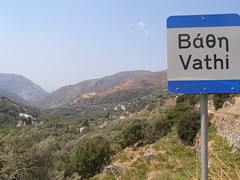

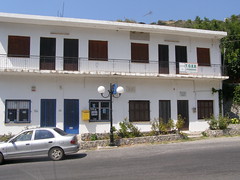

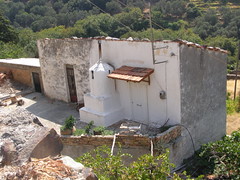
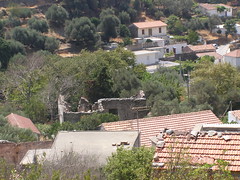
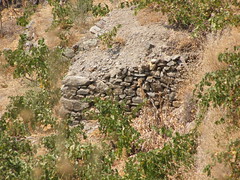
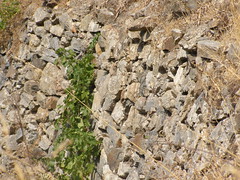

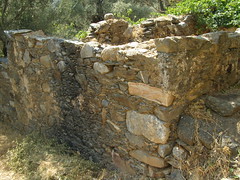
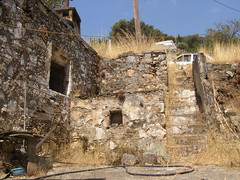
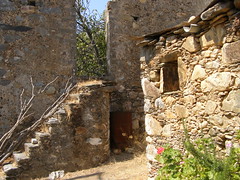
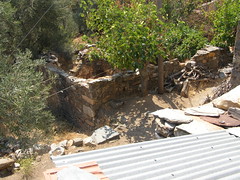
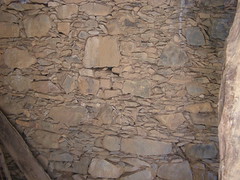
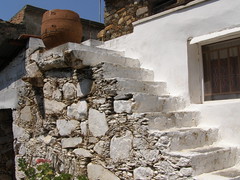
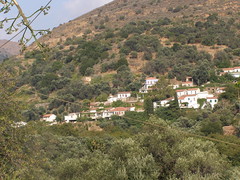
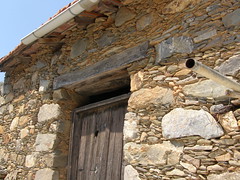

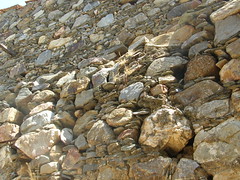
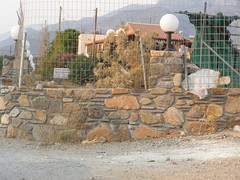
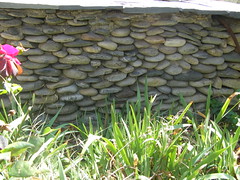
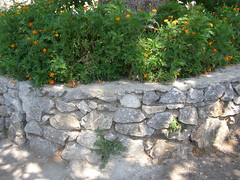
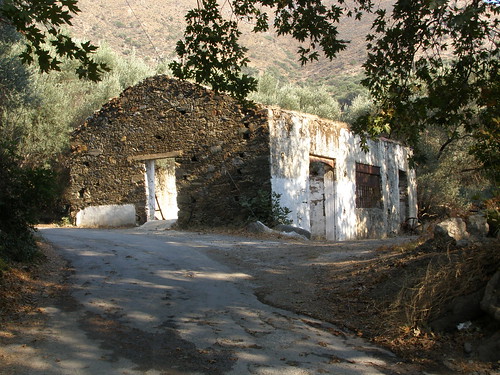
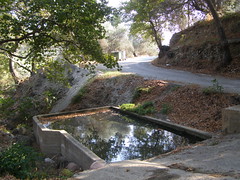


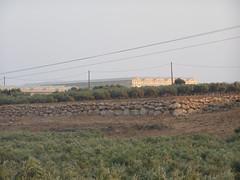
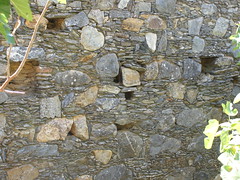
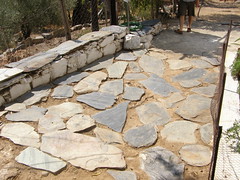

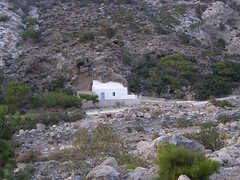
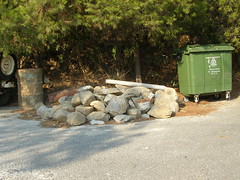



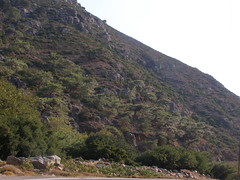
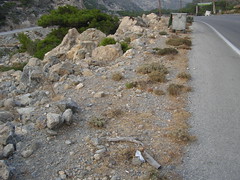
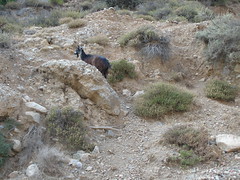
Thank you, Maria, for this thorough and thoroughly enjoyable report! I love your love for your land. And you know my love for stone.
ReplyDeleteSo God tossed up the remaining stones?! Good one. My tour guide ex- always told his tourists the reason Israel is so rocky is that every Jew who returns from exile to the Promised Land, a stone falls from his heart.
The church is beautiful. I am in awe of men who know how to place one stone on another and build a wall or a house. Someday I hope to see them in action.
All over the Jerusalem Hills we too have the old crop terraces. Some of the terrace walls are from biblical times. Piles of stone on still visible foundations are what remains of some of the houses of Arab farmers who lived here pre-1948. Sometimes I stand sadly on the rubble and wish the War of Independence could have been won in a better way.
Do they really let the sheep bathe in the sea?
And you teach all these things in this post to your kids? They must know a lot already.
I'd love to roam in Vathi. Thanks again for sharing her.
η ελληνική ύπαιθρος έχει πραγματικά μαγικές γωνιές.
ReplyDeletehistoric post! very informative and educative.
ReplyDeleteGood article, Maria and well illustrated.
ReplyDeleteThe parallel story of Vathi and Inishfree is marked - aging population, the young leaving, tourists. Even the mortar weathering out of the walls.
I believe that you love Crete much more than the locals. Your post is...WAW!!!
ReplyDeleteVisit Arhanes some day! It's my father's village and I love it!
I really envy you. You live in Crete. You see so many things every day. Thank you for shareing.
ReplyDeleteWhat a beautiful and observant meditation on the rocks of Selino as well as the more transient things: the people themselves. It is balm for the soul as we cannot be there this year to enjoy the epic drive from Chania down to the south coast. Thank you so much!
ReplyDelete